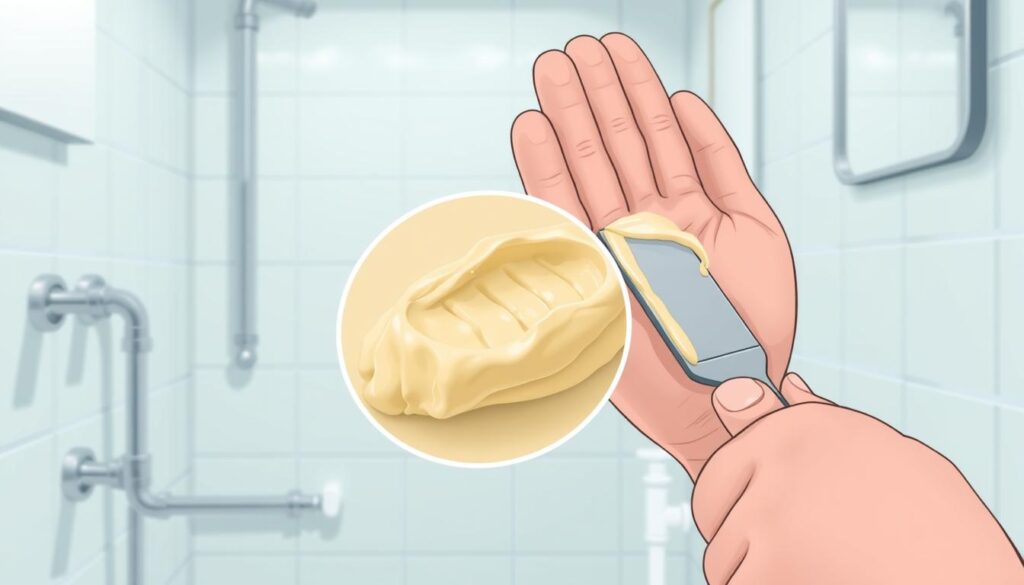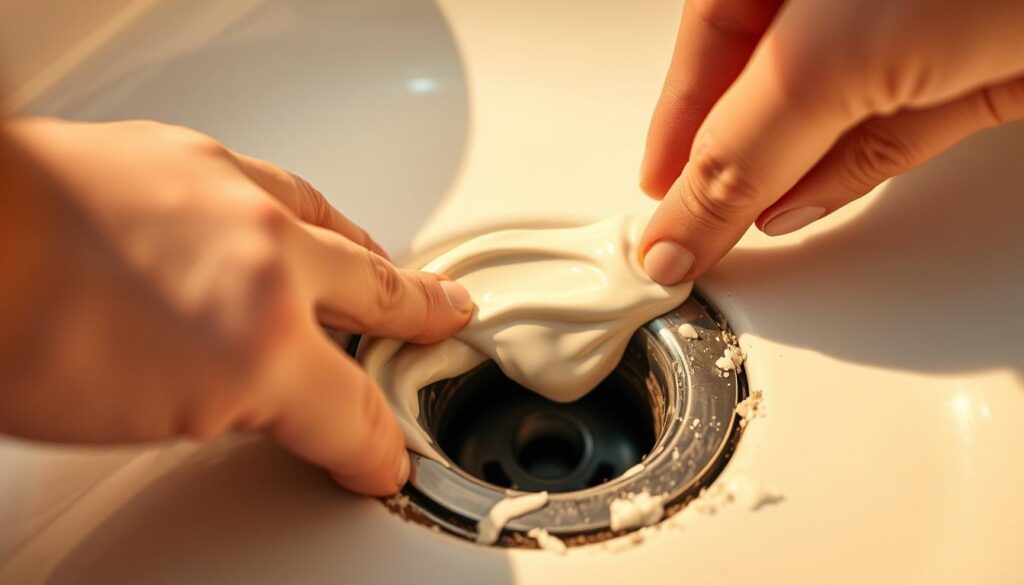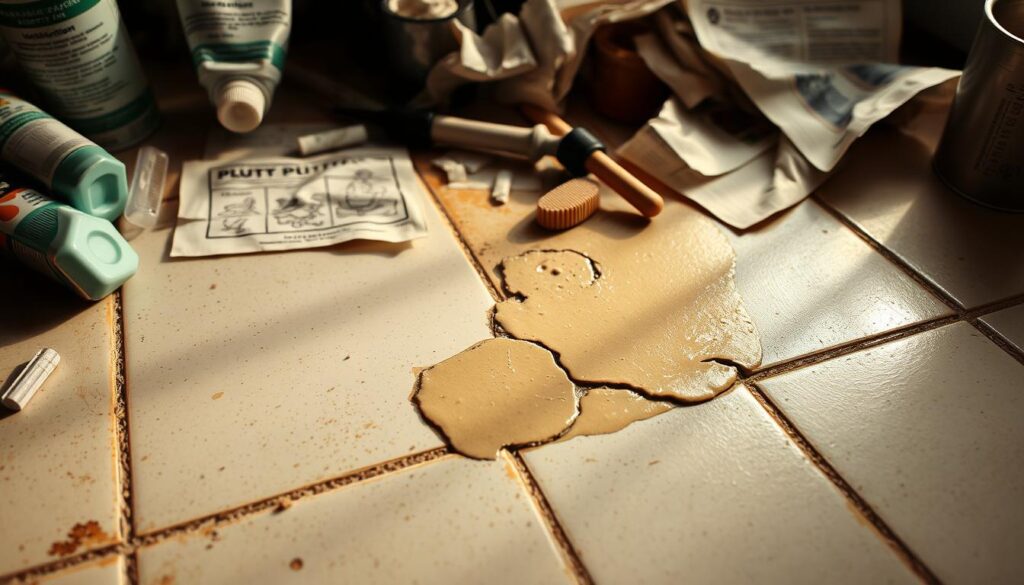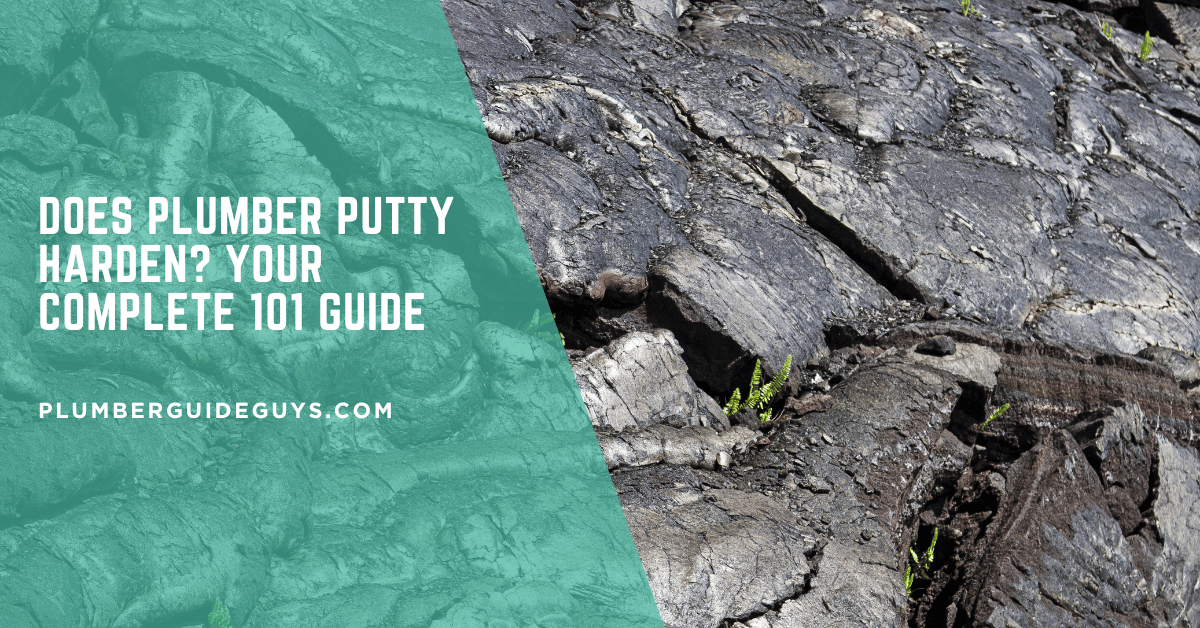Affiliate Disclosure
Plumber Guide Guys is a participant in the Amazon Services LLC Associates Program, an affiliate advertising program designed to provide a means for sites to earn advertising fees by advertising and linking to Amazon.
Does Plumber Putty Harden? Ever thought about if plumber putty hardens after you use it? Knowing how it hardens can really help with DIY plumbing and fixing things at home.

Plumber’s putty is a handy sealing material for both pros and DIY fans. But, many think it stays soft. The truth about plumber putty might surprise you.
This guide will clear up the mystery of plumber putty. We’ll look at its special features, how to use it, and if it really hardens. Whether you’re experienced or just starting, you’ll learn a lot about this key plumbing tool.
Key Takeaways
- Plumber putty is not designed to completely harden like traditional sealants
- Understanding its unique properties prevents possible installation mistakes
- Proper application is key for good sealing
- Different plumbing jobs need different sealant methods
- Using professional techniques can make your repairs better
Understanding Plumber’s Putty: Basic Properties and Uses
Plumber’s putty is a key tool for fixing things at home. It makes sure water doesn’t leak in plumbing jobs. Knowing how it works can make you more confident in fixing things.
Both pros and DIY fans use plumber’s putty for tight seals. It’s flexible and works well in many plumbing tasks. Let’s explore what it’s made of, its uses, and its main features.
What is Plumber’s Putty Made Of?
Plumber’s putty is a mix of materials for flexibility and to keep water out. It usually has:
- Clay-like base materials
- Mineral fillers
- Linseed oil
- Limestone derivatives
Common Applications in Plumbing
Plumber’s putty is used for many tasks, from small fixes to big projects. Here are some examples:
- Sealing sink drains
- Installing faucet bases
- Creating watertight connections around fixtures
- Preventing water leakage in bathroom and kitchen installations
Key Benefits and Limitations
| Benefits | Limitations |
|---|---|
| Highly malleable | Not suitable for high-pressure areas |
| Water-resistant | Can stain porous surfaces |
| Easy to apply | Limited temperature tolerance |
Plumber’s putty is a great choice for many jobs, but it has its limits. Knowing its strengths and weaknesses helps pick the right material for your plumbing needs. This ensures your repairs last and don’t leak.
Does Plumber Putty Harden? The Truth About Setting Time
Plumber’s putty is a special material for sealing. It doesn’t harden like other sealants. Knowing how long it takes to set is key for plumbing jobs.
Unlike other sealants, plumber’s putty stays soft and pliable. This makes it great for watertight seals around sinks, drains, and faucets. Its flexibility helps prevent leaks and adjusts to small movements.
- Does putty solidify? Not completely
- Remains malleable after application
- Designed to create temporary, adjustable seals
The putty sets by getting slightly firmer, not hard. This lets you easily change or remove it. Plumbers like this because it seals well and can be adjusted later.
Plumber’s putty sets in 30-60 minutes. But it never gets as hard as other sealants. This keeps your plumbing connections secure and ready for changes.
“The magic of plumber’s putty lies in its ability to seal without permanently locking components in place.” – Professional Plumbing Experts
Knowing how long plumber’s putty takes to set helps pick the right product. It ensures your plumbing stays leak-free for a long time.
The Science Behind Plumber’s Putty Consistency
Understanding plumber’s putty is key to using it right. It’s a go-to for plumbers to seal pipes. Knowing its science helps you use it better.
Chemical Composition and Behavior
Plumber’s putty is made of minerals and oils. It stays soft and pliable, unlike other sealants. This makes it perfect for quick fixes.
- Consists of clay-like minerals
- Contains petroleum-based oils
- Maintains flexibility after application
Environmental Factors Affecting Putty
Temperature and humidity change how plumber’s putty works. Extreme weather can affect its consistency. For industrial use, these factors are.
| Environmental Factor | Impact on Putty |
|---|---|
| High Temperature | Softens and potentially flows |
| Low Temperature | Becomes less malleable |
| High Humidity | May reduce adhesive properties |
Storage and Shelf Life Considerations
Storing plumber’s putty right keeps it usable longer. Keep it in a cool, dry spot in a sealed container. It stays good for 12-18 months this way.
- Store at room temperature
- Keep container tightly sealed
- Avoid direct sunlight exposure
Proper Application Techniques for Lasting Results

Learning how to use plumber’s putty can greatly improve your home repair skills. It’s key for sealing sink drains or fixing leaky fixtures. Knowing the right methods ensures a tight seal that lasts.
Before you begin, make sure you have these important tools for plumber’s putty application:
- Clean cloth
- Putty knife
- Plumber’s putty
- Dry surface
Here are the steps for applying plumber’s putty correctly:
- Clean the surface thoroughly to remove dirt or old sealant
- Roll the putty into a smooth rope-like shape
- Apply the putty around the fixture or seal area
- Press gently to create an even seal
- Remove excess putty with a clean cloth
Professional plumbers share these essential tips for the best results:
| Technique | Best Practice |
|---|---|
| Putty Thickness | 1/4 inch uniform layer |
| Application Pressure | Light, even pressure |
| Drying Time | 24-48 hours before water exposure |
Remember, practice makes perfect. Take your time and aim for a clean, smooth application. This will give you professional-looking results every time.
Comparing Plumber’s Putty vs. Silicone Sealants
When you’re working on plumbing projects at home, picking the right sealant is key. Knowing the difference between plumber’s putty and silicone sealants helps you choose the best waterproof option for your needs.
Both plumbers and DIY fans often talk about the pros and cons of plumber’s putty and silicone sealants. Each has its own strengths for different jobs.
Strength and Durability Differences
Silicone sealants are better at keeping water out and are more flexible than plumber’s putty. Here’s why:
- Silicone stays elastic for a long time
- Plumber’s putty makes a stiffer seal
- Silicone can handle bigger temperature changes
Cost and Availability Factors
| Product | Average Cost | Availability |
|---|---|---|
| Plumber’s Putty | $5-$10 | Hardware stores, online retailers |
| Silicone Sealant | $7-$15 | Wide range of home improvement stores |
Best Usage Scenarios for Each
Choosing between plumber’s putty and silicone depends on your project. Plumber’s putty is great for:
- Drain installations
- Sink fixture sealing
- Non-moving plumbing connections
Silicone sealants are best for:
- Flexible areas
- Places with lots of moisture
- Outdoor plumbing jobs
“Choose your sealant wisely – the right product can prevent costly water damage and ensure a professional-quality repair.” – Professional Plumbing Association
Common Mistakes When Using Plumber’s Putty

Working with plumber putty needs precision and attention to detail. Many DIY fans and homeowners make big mistakes. These mistakes can ruin their plumbing fixes.
Knowing the common errors can help you avoid water damage and expensive fixes. Let’s look at the main mistakes in using plumber’s putty:
- Incorrect Surface Selection: Not all surfaces work well with plumber’s putty. Don’t use it on porous materials or where drinking water will touch.
- Improper Application Thickness: Too much or too little putty can stop it from hardening right.
- Neglecting Surface Preparation: Not cleaning and drying surfaces before can cause leaks.
- Ignoring Manufacturer Instructions: Each plumber’s putty brand has its own rules to follow.
When using plumber’s putty, be patient. Hurrying can make things worse. Clean the surface, apply the putty right, and let it set well.
Experts say check the putty’s consistency and the work area before starting. Temperature and humidity affect how it hardens. So, pick the right conditions for your work.
Pro Tip: Always keep a clean cloth nearby to wipe away excess putty and ensure a neat, professional-looking finish.
Avoiding these mistakes will help your plumbing fix succeed. It will also prevent water damage to your home.
Alternative Waterproof Sealants for Plumbing Projects
When plumber’s putty doesn’t work, looking for other options is key. New sealants offer better and longer-lasting seals for plumbing tasks.
Modern Sealant Technologies
Today, we have advanced materials for plumbing challenges. These new solutions work well in different settings:
- Silicone-based sealants
- Epoxy compounds
- Polyurethane adhesives
- Specialized pipe repair tapes
When to Choose Alternatives
Choosing the right sealant depends on your project needs. Think about these points when deciding:
| Sealant Type | Best Used For | Durability |
|---|---|---|
| Silicone Sealant | Bathroom fixtures, sink connections | High water resistance |
| Epoxy Compounds | Permanent pipe repairs | Extreme durability |
| Polyurethane | Outdoor plumbing connections | Weather-resistant |
Professional Recommendations
Experts say to check your project needs before picking a sealant. Think about temperature, pressure, and movement when choosing. For important jobs, a pro can help pick the best sealant.
Pro tip: Match your sealant to the specific material and environment of your plumbing project for optimal results.
Maintenance and Troubleshooting Tips
Keeping your plumbing fixtures sealed with plumber’s putty needs careful attention. It’s important to know how long it takes for plumber’s putty to dry. Usually, it takes 24 to 48 hours, depending on the environment.
To keep your seals in good shape, follow these important maintenance tips:
- Check seals every 6-12 months for wear or damage
- Look for cracks, gaps, or color changes around the seals
- Use a soft cloth to clean the area gently
If you see problems with your plumber’s putty seal, try these steps:
- Find out how long the putty has been there
- Use a putty knife to remove old putty carefully
- Clean the area well before putting new putty on
- Make sure to apply the putty right for a tight seal
Pro tip: Store your plumber’s putty in a cool, dry place. This keeps it working well and prevents it from drying out too fast.
Remember, regular maintenance can make your plumbing seals last longer and avoid expensive water damage.
If you’re not sure about your seal or how long the putty will dry, ask a professional plumber. They can give you the right advice and make sure your plumbing is secure and leak-free.
Conclusion
Knowing if plumber putty hardens is key for plumbing success. This guide showed that plumber’s putty stays soft and pliable. It’s made to create tight seals without getting hard.
This special quality makes it vital for many plumbing jobs where being flexible is important.
When picking a sealant, think about what your project needs. Plumber’s putty is best for areas that don’t move much and have little pressure. You need to consider the project’s details, like water exposure and fixture type.
For different needs, you might choose other sealants like silicone. They have their own strengths.
Using plumber’s putty right is important. Clean the area well, use the right amount, and remove any extra carefully. This way, your plumbing will last longer and stay leak-free.
Understanding plumber putty’s properties helps you make better choices for your plumbing. With this knowledge, you’re ready to handle many home maintenance tasks confidently.

